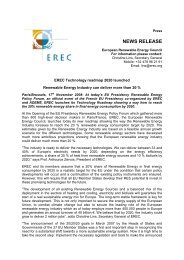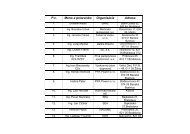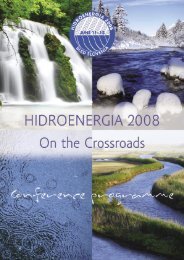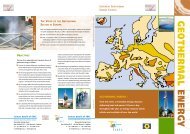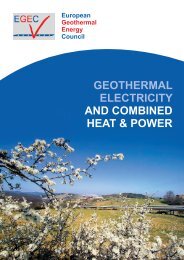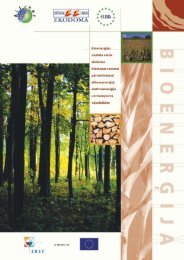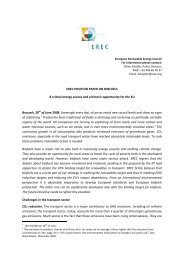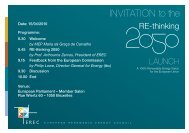CTO Assessment - European Commission
CTO Assessment - European Commission
CTO Assessment - European Commission
Create successful ePaper yourself
Turn your PDF publications into a flip-book with our unique Google optimized e-Paper software.
SAMSØ<br />
Danish Renewable<br />
Energy Island<br />
Contacts: Mr Sören Hermansen • Samsø Energi- og Miljøkontor • Samsø<br />
Tel.: +45-86 59 23 22 • Fax: +45-86 59 23 11 • E-mail: samso@sek.dk<br />
Mr JohnsenNielsen • Samsø Energy Company • Samsø • Denmark<br />
Tel.: +45 8659 3211• Fax: +45 8792 2221 • E-mail inf@veo.dk<br />
Samsø is an island geographically located<br />
almost exactly in the heart of Denmark with<br />
an area of 114 km 2 . The population of the<br />
island is about 4,400 inhabitants and main<br />
industries on the island are agriculture, tourism,<br />
and services. Total gross energy consumption<br />
is about 900 TJ/year, from which<br />
the energy consumption in the transport sector<br />
is excluded, a renewable energy (RE) accounts<br />
for 12-15%.<br />
People on the island have been trying to introduce<br />
RE since 1980’s, and then they made<br />
a energy plan together with the local utility<br />
company (NRGi) and consulting companies<br />
in order to respond to the national energy<br />
policy “Energi 21” which was approved in<br />
the parliament in 1996. In the plan it was<br />
aimed that the intensive saving of energy in<br />
the sector of power generation, heat supply,<br />
and transport would be implemented and the<br />
current energy supply system would be transformed<br />
into the renewable energy system<br />
within the next 10 years (1998-2007).<br />
The project was chosen as “Danish Renewable<br />
Energy Island” by the Danish Energy<br />
Agency in 1997, because the Danish government<br />
expected at that time that the project in<br />
Samsø would be a model of solution for the<br />
international society, authorities, planners,<br />
and not least the inhabitants of local community<br />
who were facing the many challenges.<br />
The projects<br />
Electricity supply projects: Total electricity<br />
consumption in Samsø is about 28,000<br />
MWh (101 TJ)/year.<br />
In the wind turbine project, 11 of 1MW wind<br />
turbines were built at the south of island in<br />
2000. They are producing about 27,000<br />
MWh/year, which is nearly same as the annual<br />
electricity consumption in the island and<br />
reduce CO 2<br />
by about 22,000 t/year.<br />
Heat supply projects: Total heat consumption<br />
in Samsø is about 232 TJ/year, about<br />
30% of which is made of biomass. It is<br />
considered in the plan that additional insulation<br />
and renovation of buildings, introduction<br />
of energy control and improvement<br />
in the effectiveness of heat supply<br />
plant will make it possible to cut this consumption<br />
by 21%. 60% of households will<br />
be connected to the network of district heating<br />
and remaining 40% in the rural area<br />
will be supplied with heat by individual systems<br />
such as heat pumps, solar heating,<br />
wood chips, farm-based biogas plant and<br />
household wind turbines.<br />
Projects in the transport sector<br />
Roughly 310 TJ/year is consumed in the<br />
transport sector for ferries, cars, buses, and<br />
trucks etc. Information campaigns, introduction<br />
of energy control, improvement of driving<br />
technique, changed services, and new forms<br />
of cooperation in delivering should make it<br />
possible to reduce the consumption by at least<br />
5%. Consumption can be reduced by further<br />
15% if electrically powered vehicles replace<br />
service vehicles and half of the private cars<br />
on the island.<br />
Despite the reduction and conversion to electrical<br />
cars, the transport sector will still consume<br />
250 TJ of fossil fuels per year, and<br />
therefore to supply the same amount of energy<br />
consumed in the transport sector the<br />
installation of offshore wind farm is planned.<br />
The first planning phase for a 23 MW offshore<br />
wind farm at south or west of Samsø<br />
started in the autumn of 1998. The second<br />
planning phase started in the spring of 2000.<br />
In 2002 10 wind turbines were finally built<br />
3.5 km south from Samsø. The Offshore wind<br />
farm will produce about 250 TJ of electricity<br />
which substitute the same amount of energy<br />
consumed in the transport sector. In the<br />
long term, a hydrogen plant will be established<br />
in 2005. The plant will be powered by<br />
electricity from offshore wind turbines and<br />
supply hydrogen to cars, which can be driven<br />
by hydrogen.<br />
Overall evaluation<br />
The total cost for implementation of the energy<br />
plan is about DKK 590 million, and a<br />
total subsidy of about DKK 70 million is<br />
needed in order to ensure competitive<br />
economy for consumers.<br />
However, at the same time, the island can<br />
save about DKK 54 million/year, which is<br />
used for purchasing fossil fuels and electricity,<br />
and then that money will be used for purchasing<br />
bio fuels, employing construction<br />
labour, operating new plant, financing, etc.<br />
and will circulate in the island.<br />
In terms of environment, a complete conversion<br />
of the energy supply system will mean<br />
that emissions of SO X<br />
, CO 2<br />
, and particles will<br />
be removed completely, while emissions of<br />
NO X<br />
will be reduced by about half. Moreover,<br />
to use manure in biogas plant makes it<br />
possible to reduce odours and pathogenic<br />
bacteria in manure.<br />
People’s commitment<br />
In the Samsø projects the importance is<br />
placed on people’s commitment at all levels,<br />
especially politically, technically, and financially.<br />
Foreningen Samsø Energi- og Miljøkontor<br />
and Samsø Energiselskabet which were established<br />
to promote participation of residents<br />
play an important role in this process.<br />
For example, Samsø Energiselskabet consists<br />
of representatives of Samsø municipality,<br />
the Commercial Council, the Farmer’s<br />
Association and Foreningen Samsø Energiog<br />
Miljøkontor, and its secretariat widely<br />
provides general information.<br />
Residents take both benefit from and responsibility<br />
for projects by participating them. It<br />
is very important, because it raises a resident’s<br />
interest in the projects and thereby<br />
they proceed smoothly. Therefore, it is very<br />
important for a region that wants to convert<br />
the current energy system into the RE system<br />
to make residents as involved in project<br />
as possible.<br />
<strong>CTO</strong> - Showcase<br />
59



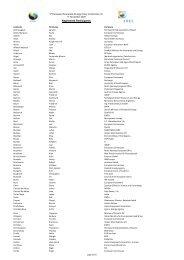
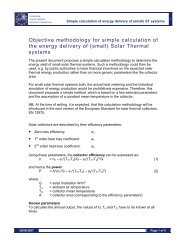
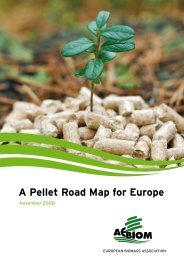
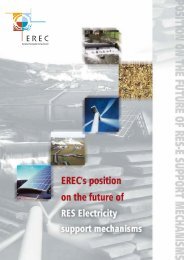

![Energy [R]evolution - Greenpeace](https://img.yumpu.com/47174859/1/184x260/energy-revolution-greenpeace.jpg?quality=85)
